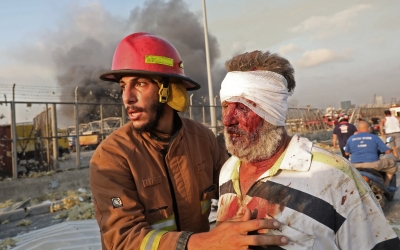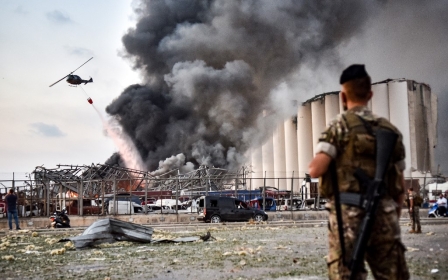Beirut explosion: 'Some of the dead will not be found'

Residents on Wednesday began clearing away glass and rubble strewn across Beirut - a city left devastated by a massive explosion that ripped through the Lebanese capital on Tuesday, killing at least 135 people and injuring more than 5,000.
Elie, the owner of a restaurant in Gemmayze, a trendy residential and commercial neighbourhood of Beirut that was hit hard by the blast, arrived early to see what was left.
'I know many of my colleagues are dead, I am just trying to find what is left of their bodies so that their family can have proper funerals and burials'
- Mohamad, local firefighter
The scene looked like a war zone, but at least none of his employees were hurt, he said.
"It's a miracle we're still alive, many restaurants in the area are mourning their colleagues," Elie told Middle East Eye, after taking some time to assess the level of destruction.
Those walking the streets of Gemmayze and nearby Mar Mikhael shared the same sentiment, comparing the once-fashionable area to that of a conflict zone, completely transformed by debris.
New MEE newsletter: Jerusalem Dispatch
Sign up to get the latest insights and analysis on Israel-Palestine, alongside Turkey Unpacked and other MEE newsletters
The two neighbourhoods were damaged due to their proximity to Beirut port, but everyone in the city was impacted in one way or another. Some lost loved ones, while others were still recovering from injuries.
'Nowhere to be found'
Much like the night before, blood still soaked the floors of the American University of Beirut and Hotel Dieu hospitals when MEE visited the facilities the morning after the explosion.
Some people were still circling the buildings, looking for relatives missing in the blast.
Fatima had been searching desperately for her fiance, who works at the port, since the explosion at about 6pm local time on Tuesday.
"I have contacted all of the hospitals and he is nowhere to be found," she told MEE.
Port workers and security personnel are among the bulk of the missing.
Mohamad, one of the firefighters who hadn't left the blast site since shortly after the explosion, told MEE that at this point, he fears he is looking for remains, rather than survivors.
"I know many of my colleagues are dead; I am just trying to find what is left of their bodies so that their families can have proper funerals and burials," he said.
A security source with the Lebanese intelligence service, who preferred not to be identified, told MEE that it is likely many of those lost will never be recovered.
"Some of the dead will not be found, but those who were in close radius of the explosion have
evaporated," the security source said.
About 2,750 tonnes of ammonium nitrate was stored at the port's warehouse number 12, after being confiscated in 2014.
Ammonium nitrate: What is it and how did it get to Beirut's port?
+ Show - HideThere are still many details surrounding the cause of the explosion that devastated much of Beirut on Tuesday that remain murky and unexplained.
However, the Lebanese government has so far indicated that they believe the enormous blast to have been the result of 2,700 tonnes of the chemical compound ammonium nitrate left lying in a warehouse in Beirut port since 2013.
Middle East Eye has compiled a quick guide to the destructive compound and the circumstances surrounding its fateful detonation on Tuesday.
What is ammonium nitrate?
Ammonium nitrate is an industrial chemical commonly used for fertilisers, but also as an explosive, often used in mining.
The chemical, known by the formula NH4NO3, is a naturally white crystalline solid and is often known as saltpetre.
Under most conditions ammonium nitrate is not necessarily dangerous and is relatively stable - it can even be used to smother a fire.
However, if contaminated it can become highly volatile.
What previous incidents have there been?
The most notorious confirmed ammonium nitrate explosion prior to Tuesday was the 1947 Texas City Disaster.
On 16 April 1947, at the Port of Texas City, 2,300 tonnes of ammonium nitrate exploded, killing almost 500 people.
More than 5,000 people were injured and at least 1,000 buildings levelled in the surrounding area.
It was the deadliest industrial accident in US history and resulted in the first-class action lawsuit against the US government on behalf of 8,485 victims.
A more recent incident involving ammonium nitrate took place in 2015 when a series of explosions at a chemical plant in the Chinese port city of Tianjin killed 173 people and injured 798.
Among the blasts at the port was the detonation of 800 tonnes of ammonium nitrate.
Eventually Chinese courts handed jail sentences to 49 government officials and warehouse executives and staff over their involvement in circumventing and loosening safety standards enabling the storage of dangerous chemicals.
How did the chemical end up in the port?
The chemicals originally arrived at Beirut's port on board a Russian-owned cargo vessel flying a Moldovan flag in September 2013.
The shipping monitoring organisation ShipArrested.com at the time reported that "upon inspection of the vessel by Port State Control, the vessel was forbidden from sailing. Most crew except the master and four crew members were repatriated and shortly afterwards the vessel was abandoned by her owners after charterers and cargo concern lost interest in the cargo".
According to documents posted online and seen by Al Jazeera, the ship's dangerous cargo was then offloaded and placed in hangar 12.
Numerous letters were reportedly sent by customs officials, including former director of Lebanese customs Shafik Merhi, to judges between 2014 and 2017 asking for guidance on what to do with the chemicals.
One letter sent in 2016 - which noted there had been "no reply" to previous requests - said the ammonium nitrate was being kept in "unsuitable" conditions.
"In view of the serious danger of keeping these goods in the hangar in unsuitable climatic conditions, we reaffirm our request to please request the marine agency to re-export these goods immediately to preserve the safety of the port and those working in it, or to look into agreeing to sell this amount," said the letter.
Another letter was sent by Lebanese customs administration director general Badri Daher on 27 October 2017 urging a resolution to the situation, in light of "the danger ... of leaving these goods in the place they are, and to those working there".
Local sources said that a malfunction had occurred with one of the warehouse's gates and technicians were called to fix the problem by welding.
Sparks caused the warehouse to catch fire, which led to a massive explosion when the blaze hit the ammonium nitrate.
'Death is what's common'
MEE toured different areas in Beirut, talking with citizens who witnessed the disaster.
The buildings were heavily damaged on Hamra Street, about 10 to 15km away from the blast site. Marwan, a retail shop owner, said that at the time of the explosion, he and his neighbours thought it had occurred there, not the port, because the shockwave was felt so intensely.
'Tuesday at 6pm, Beirut no longer had a port, but rather a new mass graveyard'
- Local journalist
The magnitude of the explosion seemed to make everyone in Beirut feel as if the blast had happened nearby.
One of Marwan's friends, a port worker, died at the hospital after sustaining serious injuries.
"He worked in one of the shipping companies at the port. I was told he was injured, [but] when I arrived at the hospital yesterday he was declared dead," he said.
Marwan seemed at ease talking about his friend's death. When asked if he was still in shock, he said that was just the way in Lebanon. "It seems that in this country we only live by mistake, and death is what's common," he said.
One scene seemed to be repeated across the city: People cleaning glass from the streets while expressing relief for other's safety and offering condolences for the deceased.
'A new mass graveyard'
One local reporter told MEE that since last night he had taken on the role of medic in addition to journalist, as he walked the streets of Beirut.
The disaster was too big to be handled only by first responders, he said.
"While we were moving from the Gemmayze to Mar Mkhayel, we were stopped by a woman, begging us to help her bring down her elderly mother who was still stuck on the 5th floor," he said, adding that the woman had tried to call emergency teams but everyone was too busy attending to the dead and wounded.
Another journalist said that when he arrived at the scene of the blast, shortly after it had taken place, a soldier warned him not to step on any bodies.
"I stopped and looked around, and I realised I was surrounded by dead bodies that were so covered by mud and soil, [that] I couldn't [tell they were] dead bodies," he said.
"Tuesday at 6pm, Beirut no longer had a port, but rather a new mass graveyard," he added.
Middle East Eye delivers independent and unrivalled coverage and analysis of the Middle East, North Africa and beyond. To learn more about republishing this content and the associated fees, please fill out this form. More about MEE can be found here.






